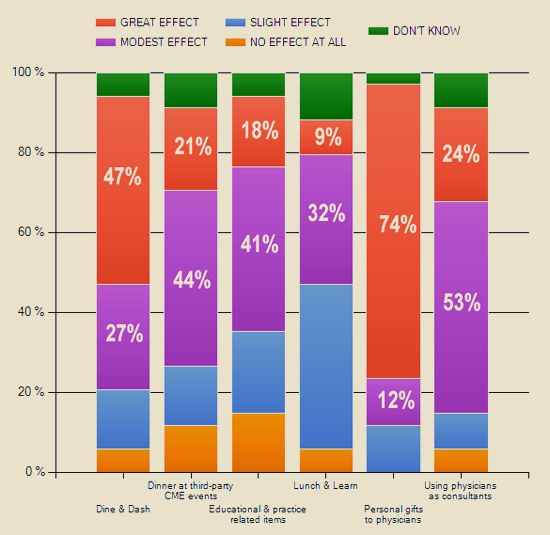Impact of PhRMA Code on Pharmaceutical Marketing & Sales Survey (Survey ran from 21 April 2004 through 20 May 2004. N=34 respondents)
See Resources & Further Reading below…
The PhRMA Code on Interactions with Healthcare Professionals, which became effective in July 2002, affirms that a sales rep’s primary function is to educate and inform doctors. In pursuit of this function, certain activities are supposed to be forbidden. However, there may be some differences among pharmaceutical companies regarding the interpretation of the Code and how it is applied in practice.
Questions asked:
- In your opinion, what ACTUAL effect has the Code had on the following activities supporting physician marketing and sales? (See below.)
- In your opinion, how important are the following activities — permitted by the Code or not — for helping sales reps gain access to physicians?
- Please estimate how much currently is spent (in dollars) each month by the industry per sales rep on the following activities (see list above).
- In your opinion, who within the pharmaceutical company, determines the budget for permitted activities such as Lunch & Learn and educational and practice related items?
- In your opinion, what is the most important consideration when allocating funds for the sales rep’s monthly direct to physician budget?
Survey Results:
Selected results are summarized below. Access a more detailed online Summary of Responses plus view comments from respondents here.
Respondents were asked: “In your opinion, what ACTUAL effect has the Code had on the following activities supporting physician marketing and sales? (NO EFFECT means no cutback in activity, GREAT EFFECT means complete halt in activity.)” Response choices: No Effect Al All, Slight Effect, Modest Effect, Great Effect, Don’t Know.
The activities were:
- Dine & Dash
- Dinner at third-party CME events
- Educational & practice related items
- Lunch & Learn
- Personal gifts to physicians
- Using physicians as consultants

- Editorial Summary, which presents highlights of selected results (PDF format).
- PMN Article: PhRMA Code Succeeding — So Far.




![6 Digital Tools at the Center of Healthcare Digitalization [INFOGRAPHIC]](http://ec2-54-175-84-28.compute-1.amazonaws.com/pharma-mkting.com/wp-content/uploads/2021/04/6DigitalTools_600px-100x70.jpg)




